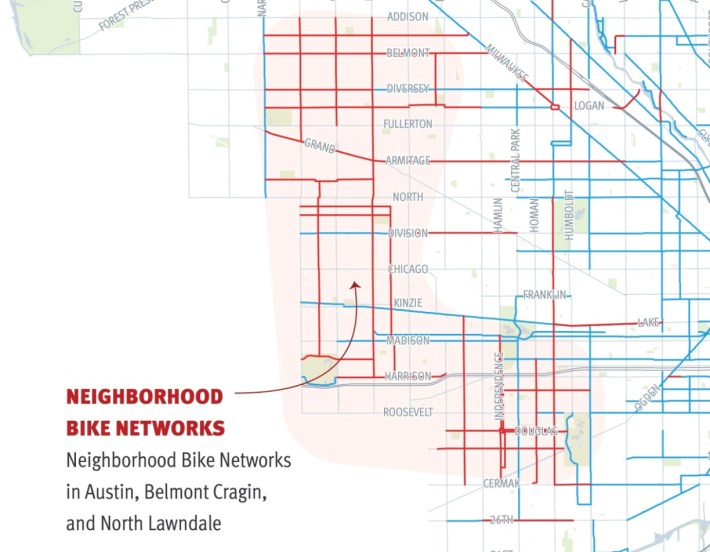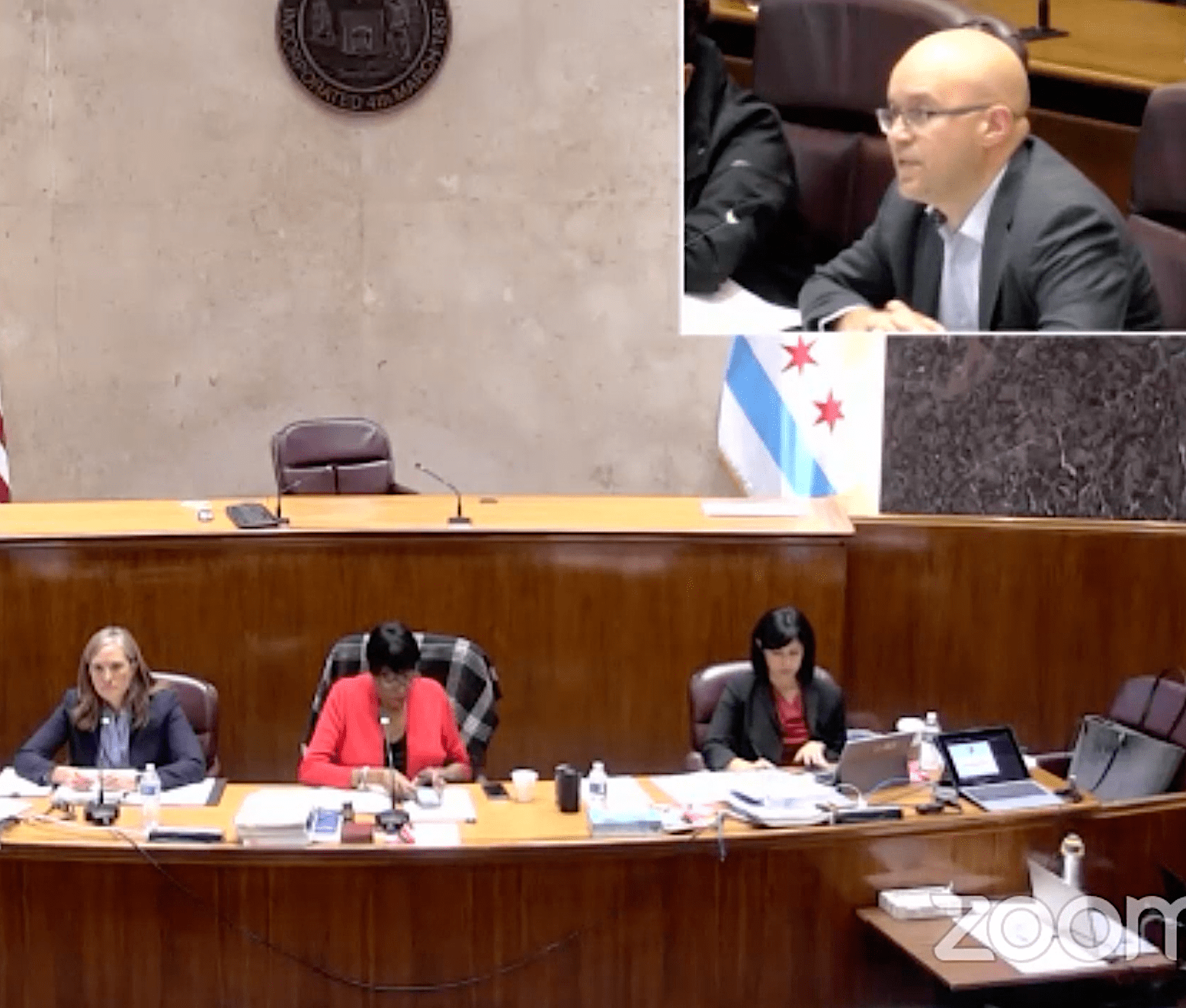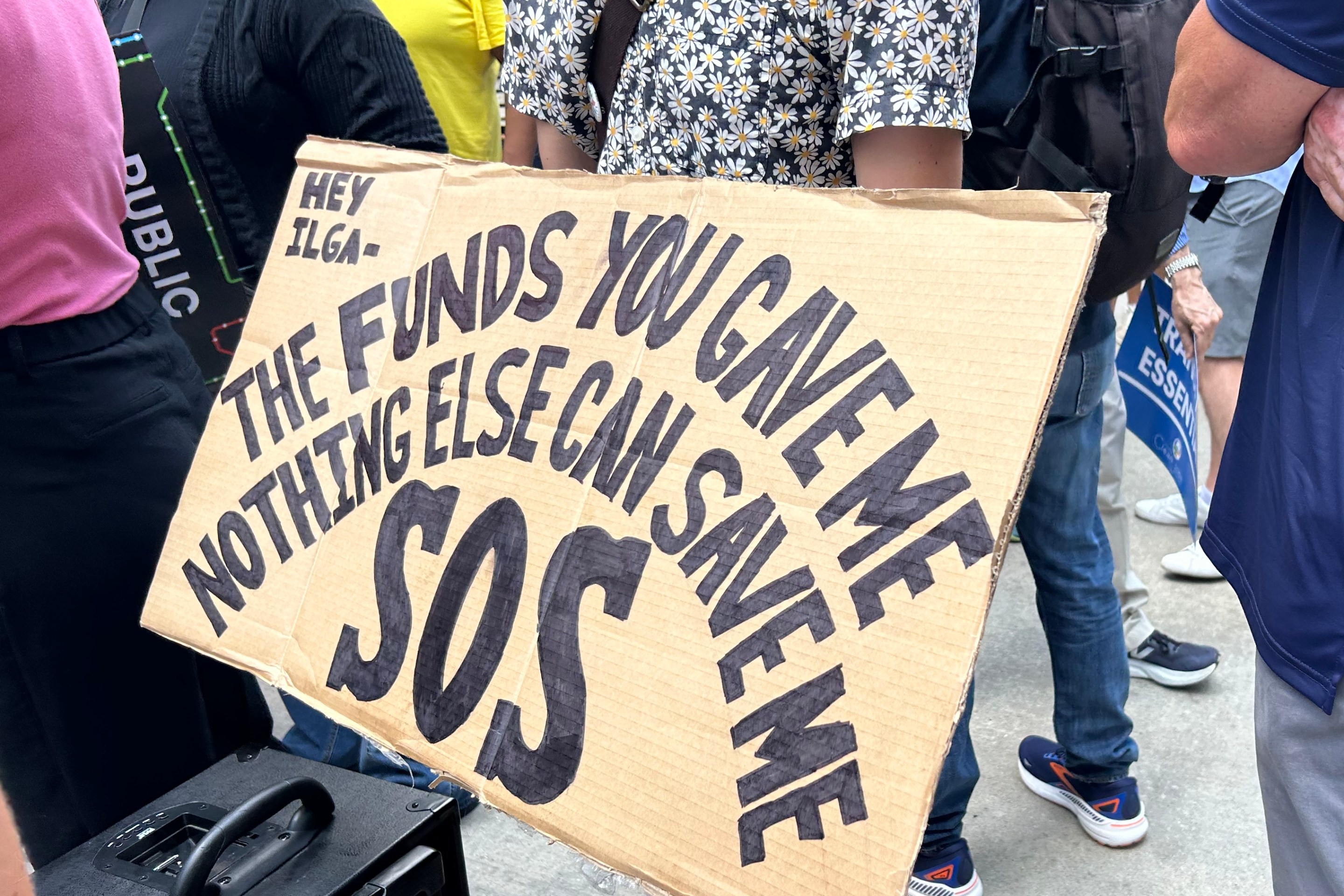One of the major takeaways from today's City Council hearing on the Chicago Department of Transportation's proposed 2023 budget is that livable streets advocacy works. Alderpersons are clearly paying attention to lobbying efforts by groups like the Active Transportation Alliance; Better Streets Chicago; Bike Lane Uprising; and Chicago, Bike Grid Now, because during the three-and-a-half-hour Q & A many of them mentioned hearing from proponents of better walk/bike/transit policies. Better still, several reps requested that CDOT pursue some of the strategies the advocates have been pushing. These included lowering our city's default speed limit from 30 to 25 mph, and building a citywide network of connected, protected bike lanes.
Transportation chief Gia Biagi opened the meeting by highlighting CDOT's 2022 accomplishments, including the installation of energy efficient "smart" street lighting, "mobility improvements" in Jackson Park for the Obama Presidential Center, breaking ground on the Damen Avenue Green Line station, and nearly completed bridge rehab projects. She also said over 400 pedestrian safety projects will have been completed citywide this year, and claimed the department has installed 40 miles of "new bikeway investments" since 2020.
West Side alder. Michael Rodriguez (22nd) praised CDOT as being one of Chicago's most effective departments, but said he wants to be done to improve traffic safety, noting that local newspapers are full of traffic violence headlines nowadays. He called for lowering the speed limit citywide.
Biagi responded that traffic deaths have spiked during the COVID-19 pandemic, with 174 on-street Chicago fatalities last year. She said the most common factor in these tragedies is speeding: "Speed kills." She added that CDOT is using infrastructure to calm traffic and make walking safer, such as sidewalk bump-outs to shorten crossing distances, and prevent drivers from whipping around corners at high speeds. She said the department has been advocating for more federal funding for bike-ped safety infrastructure, and well as federal regulations mandating car and truck designs that help keep people outside the vehicle safe.
"Folks are scared," Rodriguez responded. "I do get a sense, particularly from the bike community, that we're not moving fast enough. People are dying." He asked how this is reflected in the proposed budget.

Biagi cited the department's new community bike network strategy, creating grids of bike lanes in underserved communities like North Lawndale, Austin, and Belmont Cragin. "We've added more than 100 miles of new bikeways, and 75 percent of that is on South and West sides." She said that under Mayor Lori Lightfoot, the number of miles of protected bike lanes installed has risen from 24 to 42 miles. Biagi added that the mileage for Neighborhood Greenways, traffic-calmed side street bike routes, has increased from 11 to 44 miles under Lightfoot. (Streetsblog has not verified these numbers.)
"I hear you, but it still seems like we're moving too slow," Rodriguez said. He suggested that the city earmark more money for bike infrastructure, rather than relying on the $1.5 million in menu money, discretionary funds, allocated annually to each ward.
Far North Side alder Debra Silverstein (50th) also expressed concern for cyclist safety, noting that drivers fatally struck eight bike riders in Chicago so far this year. Last year an off-duty police officer ran over and killed Herschel Weinberger, 9 on his bike in Silverstein's ward, but in July Silverstein voted for a failed ordinance to allow 9 mph speeding near schools and parks.
She asked what CDOT does in response to fatal bike crashes in order to help prevent more fatalities. Deputy commissioner Kevin O'Malley responded that department staff study the intersection to look at opportunities for safety improvements, and eventually make these recommendations available to the public in a report.
North Lakefront alderperson Tom Tunney, who's stepping down next year and may be running for mayor, noted that there are ten positions that are currently open in CDOT's division of project development, which is slowing down the process of getting safety improvements made. Biagi acknowledged, "We have a number of hard-to-fill positions, particularly in planning and design."
Tunney asked for an update on the North Lake Shore Drive Reconstruction project, stating that community members feel left out of the planning for the entrances and exists to the drive, presumably out of concerns that these will become more car-centric. "There's a lot of angst." He asked when there will next be in-person community meetings.
Biagi said she expects there will be a community meeting by the second quarter of 2023. She added that 5,000 respondents took an online survey on the project. She said multiple potential layouts for transit improvements are still under consideration. Advocates have been pushing for converting two of the eight existing lanes to transit-only or, better yet, converting the massive highway into a human-scale, multimodal boulevard.

Mid North Side alder Scott Waguespack (32nd) called for standardizing pedestrian safety improvements around schools. He said the CTA has been opposed to curb extension on some of its routes out of concerns that they might impede buses. Biagi responded that CDOT has been coordinating with the transit authority to install bus bulb-outs, which make it easier for pedestrians to access buses, while eliminating the need for bus drivers to pull to the curb, along Belmont Avenue in Lakeview.
Recently appointed Near South alderperson Nicole Lee (11th) said that soon after taking office she did a tour of the ward on Divvy bikes with Biagi, "which was great." She noticed that protected bike lane prices went up the most of all the items on this year's menu budget. Biagi said this is due to the department changing its default protected bike lane design from flexible plastic posts to concrete curbs.
North Lakefront alder Harry Osterman, who's stepping down after this term, noted that there has been an increase in crashes on DuSable Lake Shore Drive and said he wants to lower the speed limit on Broadway. He asked why CDOT can't simply "pull the trigger" on lowering the citywide speed limit to 25 mph.
Biagi responded that, unfortunately, the Illinois Department of Transportation sets speed limits on the streets it controls based on the 85th percentile speed rule. This is the ludicrous notion that the proper speed limit for a road is that at which 85 percent of drivers will tend to stay at or below the limit, as opposed to a lower speed limit with better safety outcomes. She added that CDOT is trying to work with the state to reduce the amount of red tape required by IDOT in order for the city to install safety infrastructure on state roads.
Osterman also argued, "There can't be motorized bikes and scooters on the Lakefront Trail... someone's going to die. If you're going 40 mph on an e-bike, you can ride on Sheridan." Divvy electric bikes are capped at 20 mph, but some private e-bikes go faster. The alder's concern was lampooned by some bike advocates.
"Glad Alderman Osterman is keeping his eye on the most important traffic safety issues," tweeted Jeremy Glover. "Those e-bikes are killing people by the dozens. The Lakefront Trail runs red."
Damn e-bikes.https://t.co/ZeaaKeDUAF
— Bikes Are 👻 Green Vehicles 🎃 (@NWChiFiets) October 24, 2022
Downtown rep Brendan Reilly praised the city's upgrading of bike lanes with concrete curbs but noted, "The width of the bike lane still allows goofballs to park in them." He suggests installing bollards at the openings of lanes to keep drivers out.
Reilly argued that enforcement of bike lanes needs to improve as well. Biagi responded that CDOT "needs to look at every tool in the toolbox" to address the problem, including more effective permitting of construction sites, including requirements that the contractor provide safe bike detours, as well as the possibility of camera enforcement of bike and bus lanes.
The alder also argued that more needs to be done to improve safety at DLSD's downtown intersections, where drivers routinely endanger pedestrians and cyclists by running reds. Last week CDOT added new concrete medians to prevent drivers from using left-turn lanes as through lanes, but Reilly said more needs to be done.
"We're seeing some really dangerous situations on DLSD at Randolph and Balbo," where a driver killed Divvy rider Gerardo Marciales, 41, last February. "I know the bicycle community has been out there doing actions. Can we raise these pedestrian crosswalks and make an actual physical barrier?"
Biagi said CDOT is in talks with IDOT about further improvements. "We really need to do more."
West Side alderperson Jason Ervin (26th) said he's been getting an earful from bike riders about protected bike lanes in the Garfield Park green space filling up with parked cars on weekend. "We've got to do a better job about educating the public about the need and necessity of these bike lanes. He said advocates have been "hyper-vocal" about the issue.
Hey, the squeaky wheel gets the the grease, so bike advocates should stay noisy.
Read our full Twitter thread on the hearing, including quotes from many other alders, here.





